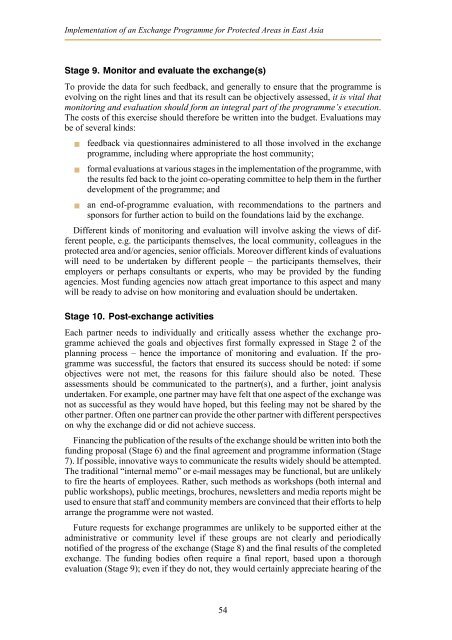Exchange programmes - IUCN
Exchange programmes - IUCN
Exchange programmes - IUCN
Create successful ePaper yourself
Turn your PDF publications into a flip-book with our unique Google optimized e-Paper software.
Implementation of an <strong>Exchange</strong> Programme for Protected Areas in East Asia<br />
Stage 9. Monitor and evaluate the exchange(s)<br />
To provide the data for such feedback, and generally to ensure that the programme is<br />
evolving on the right lines and that its result can be objectively assessed, it is vital that<br />
monitoring and evaluation should form an integral part of the programme’s execution.<br />
The costs of this exercise should therefore be written into the budget. Evaluations may<br />
be of several kinds:<br />
� feedback via questionnaires administered to all those involved in the exchange<br />
programme, including where appropriate the host community;<br />
� formal evaluations at various stages in the implementation of the programme, with<br />
the results fed back to the joint co-operating committee to help them in the further<br />
development of the programme; and<br />
� an end-of-programme evaluation, with recommendations to the partners and<br />
sponsors for further action to build on the foundations laid by the exchange.<br />
Different kinds of monitoring and evaluation will involve asking the views of different<br />
people, e.g. the participants themselves, the local community, colleagues in the<br />
protected area and/or agencies, senior officials. Moreover different kinds of evaluations<br />
will need to be undertaken by different people – the participants themselves, their<br />
employers or perhaps consultants or experts, who may be provided by the funding<br />
agencies. Most funding agencies now attach great importance to this aspect and many<br />
will be ready to advise on how monitoring and evaluation should be undertaken.<br />
Stage 10. Post-exchange activities<br />
Each partner needs to individually and critically assess whether the exchange programme<br />
achieved the goals and objectives first formally expressed in Stage 2 of the<br />
planning process – hence the importance of monitoring and evaluation. If the programme<br />
was successful, the factors that ensured its success should be noted: if some<br />
objectives were not met, the reasons for this failure should also be noted. These<br />
assessments should be communicated to the partner(s), and a further, joint analysis<br />
undertaken. For example, one partner may have felt that one aspect of the exchange was<br />
not as successful as they would have hoped, but this feeling may not be shared by the<br />
other partner. Often one partner can provide the other partner with different perspectives<br />
on why the exchange did or did not achieve success.<br />
Financing the publication of the results of the exchange should be written into both the<br />
funding proposal (Stage 6) and the final agreement and programme information (Stage<br />
7). If possible, innovative ways to communicate the results widely should be attempted.<br />
The traditional “internal memo” or e-mail messages may be functional, but are unlikely<br />
to fire the hearts of employees. Rather, such methods as workshops (both internal and<br />
public workshops), public meetings, brochures, newsletters and media reports might be<br />
used to ensure that staff and community members are convinced that their efforts to help<br />
arrange the programme were not wasted.<br />
Future requests for exchange <strong>programmes</strong> are unlikely to be supported either at the<br />
administrative or community level if these groups are not clearly and periodically<br />
notified of the progress of the exchange (Stage 8) and the final results of the completed<br />
exchange. The funding bodies often require a final report, based upon a thorough<br />
evaluation (Stage 9); even if they do not, they would certainly appreciate hearing of the<br />
54






